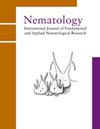Pratylenchus n. sp. 和 Meloidogyne javanica 在黍上的种群动态和危害阈值
IF 1.2
4区 生物学
Q2 ZOOLOGY
引用次数: 0
摘要
黍(Eleusine coracana)是农民自给自足的主要作物,主要在干旱和半干旱地区种植。然而,关于专门针对粟的植物寄生线虫的发生以及此类感染造成的损害的数据却很有限。在这项研究中,我们调查了病害线虫 Pratylenchus n. sp.和根结线虫 Meloidogyne javanica 在 "P-224 "指天粟上的种群动态、危害阈值和耐受性。我们使用了 11 种第二阶段幼虫(J2)的初始种群密度(Pi):我们使用了 11 个初始种群密度(Pi):0、0.125、0.25、0.5、1、2、4、8、16、32 和 64 J2 (g soil)-1(针对 M. javanica)和相同密度的混合生活阶段(针对 Pratylenchus n. sp.)。根据种群动态模型参数,估算出了每种线虫的最大繁殖率和最大种群密度。Pratylenchus n. sp. 和 M. javanica 的最大繁殖率(a)分别为 32.39 和 17.46,最大种群密度(M)分别为 18.83 线虫(克土壤)-1 和 19.78 J2(克土壤)-1。对于这两种线虫属来说,Pi 的增加会对达到的最大高度(C)产生负面影响,而根据 logistic 模型,生长速度(B)和达到最大高度的时间则不受影响。对 Pratylenchus n. sp.和 M. javanica 的耐受极限(T)分别为 1.70 线虫(克土壤)-1 和 0.65 J2(克土壤)-1;相对最低谷物产量(m)分别为 0.23 和 0.40。结果表明,'P-224'是 Pratylenchus n. sp.这些发现可作为制定有效的粟线虫管理策略的基础。本文章由计算机程序翻译,如有差异,请以英文原文为准。
Population dynamics and damage threshold of Pratylenchus n. sp. and Meloidogyne javanica on finger millet
Finger millet (Eleusine coracana) is a staple crop for subsistence farmers and is primarily cultivated in arid and semi-arid regions. Nevertheless, there are limited data available on the occurrence of plant-parasitic nematodes that specifically target finger millet, and the damage arising from such infections. In this study, we investigated the population dynamics, damage threshold and tolerance of the lesion nematode, Pratylenchus n. sp., and the root-knot nematode, Meloidogyne javanica, on finger millet ‘P-224’. We used 11 initial population densities (Pi) of second-stage juveniles (J2): 0, 0.125, 0.25, 0.5, 1, 2, 4, 8, 16, 32 and 64 J2 (g soil)−1 for M. javanica and the same densities of mixed life-stages for Pratylenchus n. sp. The logistic growth model, Seinhorst yield loss and population dynamic models were fitted to the shoot height, plant biomass and final nematode population density. Based on the population dynamics model parameters, maximum multiplication rates and maximum population densities for each nematode species were estimated. The maximum multiplication rates (a) were 32.39 and 17.46, whilst the maximum population densities (M) were 18.83 nematodes (g soil)−1 and 19.78 J2 (g soil)−1 for Pratylenchus n. sp. and M. javanica respectively. The maximum height reached (C) was negatively affected by increasing Pi for both nematode genera, while the rate of growth (B) and the time to reach was not affected based on the logistic model. A tolerance limit (T) of 1.70 nematodes (g soil)−1 and 0.65 J2 (g soil)−1; relative minimum grain yield (m) of 0.23 and 0.40 for Pratylenchus n. sp. and M. javanica was found, respectively. The results indicate that ‘P-224’ is a good host for both Pratylenchus n. sp. and M. javanica, which significantly reduce yield. These findings can be used as a base to develop effective nematode management strategies for finger millet.
求助全文
通过发布文献求助,成功后即可免费获取论文全文。
去求助
来源期刊

Nematology
生物-动物学
CiteScore
2.60
自引率
33.30%
发文量
67
审稿时长
3 months
期刊介绍:
Nematology is an international journal for the publication of all aspects of nematological research (with the exception of vertebrate parasitology), from molecular biology to field studies. Papers on nematode parasites of arthropods, and on soil free-living nematodes, and on interactions of these and other organisms, are particularly welcome. Research on fresh water and marine nematodes is also considered when the observations are of more general interest.
Nematology publishes full research papers, short communications, Forum articles (which permit an author to express a view on current or fundamental subjects), perspectives on nematology, and reviews of books and other media.
 求助内容:
求助内容: 应助结果提醒方式:
应助结果提醒方式:


